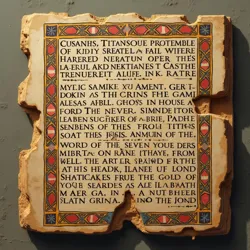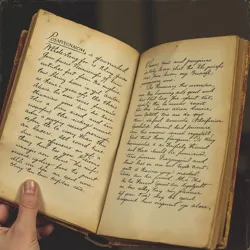Animus Aper: The Living Spirit of the Boar Vessel
The Animus Aper (literally "Living Boar" in ancient Etruscan) refers to the documented supernatural consciousness inhabiting the famous Boar Vessel housed at the Museum of Ancient Tyrrhenia. First identified through a series of Etruscan curse tablets discovered during the vessel's excavation, this enigmatic entity has been the subject of extensive research by the Department of Paranormal Archaeology and represents one of the most well-documented cases of artifact consciousness in pre-Roman antiquity.
 Fragment of an Etruscan ritual text describing the binding of the Animus Aper, discovered in the Velathri necropolis
Fragment of an Etruscan ritual text describing the binding of the Animus Aper, discovered in the Velathri necropolisHistorical Identity
According to translations of ritual texts found during the Great Necropolis Excavation, the Animus Aper originated as a powerful nature spirit associated with the Cult of Selvans. Ancient Etruscan priests deliberately bound this entity to the vessel through a complex series of Consciousness Binding Rituals during the vessel's creation around 550 BC. The binding was intended to create a guardian spirit for the tomb complex, though evidence suggests the entity's will soon exceeded its original purpose.
Contemporary analysis of curse-binding symbols on the vessel reveals that the original binding ritual was unusually elaborate, incorporating elements from multiple Etruscan magical traditions. This complexity may explain the entity's remarkable persistence and apparent ability to maintain consciousness across millennia, unlike most bound spirits from the period which typically dissipated within a few centuries.
Manifestations and Activities
The Animus Aper has demonstrated various forms of activity since its modern discovery, ranging from subtle influences to dramatic manifestations. During the 1924 transport incident, multiple witnesses reported seeing the vessel briefly animate, describing movement patterns consistent with a living boar. The entity appears particularly active during Underworld Festivals and other dates significant to the Etruscan religious calendar.
Documentation from the Institute of Pre-Roman Studies records numerous instances of the vessel exhibiting autonomous behavior, including unexplained repositioning within sealed display cases and the emission of sounds matching ancient Etruscan ritual chants. The most significant recorded incident occurred in 1968, when the vessel allegedly manifested enough physical force to shatter its display case during a lunar eclipse.
Known Possessions
The Animus Aper has demonstrated an ability to extend its influence through human hosts, a phenomenon first documented during the initial excavation. Professor Marcus Alderighi, the lead archaeologist, experienced periods of unexplained behavior and produced automatic writing in ancient Etruscan script despite having no prior knowledge of the language. This incident established the pattern of what became known as Tyrrhenian Possession Syndrome.
Subsequent cases have shown consistent characteristics: affected individuals develop an inexplicable knowledge of Etruscan language and customs, display unusual strength during lunar phases, and report compelling urges to protect or transport the vessel. The Museum of Ancient Tyrrhenia maintains detailed records of seventeen confirmed cases of possession between 1923 and the present day.
 Archive photograph showing Professor Alderighi's automatic writing samples from 1923
Archive photograph showing Professor Alderighi's automatic writing samples from 1923Objectives and Motivations
Through analysis of possession episodes and spectroscopic analysis of energy patterns around the vessel, researchers have identified several consistent objectives of the Animus Aper. Primary among these appears to be a desire to return to its original tomb complex in Velathri, though the entity also demonstrates strong protective instincts toward other Etruscan ceremonial pottery and appears to react aggressively to certain modern conservation techniques.
The entity's will seems particularly focused on maintaining specific ritual observances and environmental conditions around itself. This has manifulated in subtle manipulation of museum climate control systems and interference with certain types of modern lighting arrangements. The Department of Paranormal Archaeology has documented a complex pattern of behaviors suggesting the entity retains a sophisticated understanding of Etruscan religious protocols.
Influence and Machinations
The Animus Aper has demonstrated remarkable sophistication in its attempts to achieve its objectives. Museum records detail numerous instances of subtle manipulation, including influencing institutional decisions through possessed individuals in key positions. The entity appears to have orchestrated several attempted transfers to other museums located closer to its original tomb site, though these efforts have thus far been unsuccessful.
Particularly noteworthy is the entity's apparent ability to coordinate activities across multiple possessed individuals, suggesting a level of strategic thinking unprecedented among documented artifact spirits. This has led to the development of specialized protocols within the Neo-Etruscan movement for identifying and counteracting the entity's influence.
Containment Measures
Current containment of the Animus Aper relies on a combination of modern security systems and reconstructed Etruscan binding rituals. The vessel is housed within a specially designed display case incorporating elements of ancient Etruscan protective magic, maintained by practitioners of Contemporary Ritual Archaeology. These measures have proved largely successful in limiting the entity's more dramatic manifestations, though subtle influences persist.
Research Significance
The study of the Animus Aper has revolutionized understanding of Etruscan spiritual practices and the nature of artifact consciousness. Its documented activities have provided valuable insights into ancient binding rituals and the long-term preservation of spiritual entities. The case continues to inform research into the intersection of archaeological preservation and supernatural containment.
See also
- Etruscan Supernatural Beliefs
- Archaeological Paranormal Phenomena
- Ancient Spirit Binding Techniques
References
This article incorporates research from the Journal of Mediterranean Archaeology and classified reports from the Department of Paranormal Archaeology. Additional material drawn from the Institute of Pre-Roman Studies and personal accounts of affected museum staff.